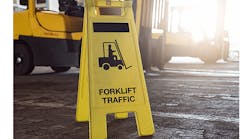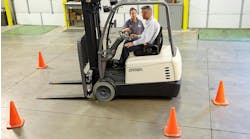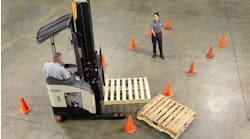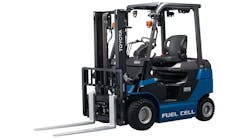Forklifts are constantly in motion, playing a significant role in the world of commerce. With that notion, keeping safety top of mind is critical in material handling.
Almost 100,000 accidents happen each year around forklifts. While even one injury or incident resulting from the misuse of forklifts is too many, there are tools and methods that can help create a safe environment and help avoid future occurrences. Some contributing factors to watch out for in helping to prevent accidents are workspace layout and design, inadequate training and improper maintenance. It’s essential to incorporate the right safety techniques in these key areas.
WORKSPACE LAYOUT AND DESIGN
Best practices in warehouse/pedestrian safety begin with the design of the workspace and understanding what the material flow and its frequency and volume is intended to be. A poorly designed material flow and aisle layout can be main contributors to forklift accidents.
If a facility is operating multiple forklifts, whether it be the same model or different classes of trucks, make sure the design is built out effectively. Fleet managers may need to segregate the forklifts, so they are not traveling where they don’t belong. The workplace should be very organized and visually easy to manage. This can help contribute to a safer work environment.
The design also needs to take into consideration the model of the truck in operation. Many trucks are not applicable for a particular environment. For instance, a class IV or V truck is just too big for a narrow aisle, and its turning radius may not be appropriate for an area designed for a class II vehicle. It’s important to identify the right type of forklift(s) for a specific workspace need.
OPERATOR TRAINING
According to OSHA, 70% of all forklift accidents could be avoided with proper training and policy. While there is a misconception that a forklift feels similar to driving a car, there are differences. Not only are there multiple classes of forklifts, but each has its own application and environment it caters to.
Under OSHA laws and regulations, employers are required to train and evaluate forklift operators. Operator training typically begins in the classroom to understand the safety principles and the fundamentals of forklift operation and maintenance, like the proper way to get on and off the forklift and how to refuel or charge a battery. Training is specific to the model of forklift the operator will be authorized to operate.
After educational training is complete, operators are then directed to a hands-on/practical interaction with the forklift, where they are placed into a safe environment for evaluation. It’s typically best practice to place the operator in an environment that is similar to what they would be doing, so they can be evaluated effectively. Employers are ultimately required by OSHA to evaluate the operator’s performance in the workplace.
Retraining is also important for operators who have been in the field for a long time and is required at least once every three years. Many operators who have been in the business for a long time are noticing that a lot has changed over the years, especially related to technology. The skill set is changing as technology becomes more advanced. All drivers can benefit from a refresher training course.
In addition, service technicians should have not only proper operating training but also proper technical training. This gives them the expertise needed to understand the proper operation, location and function of the safety features designed into the equipment and how to properly troubleshoot, diagnose and repair the truck safely.
Many suppliers and OEMs are implementing these training methods in-house, but there are other sources that offer training like local community colleges and other third-party businesses. The challenge with using these types of resources is that scheduling does not always align with a facility’s timeline. It may be difficult to get someone trained and certified quickly, so in-house training is a great tool to have. Fleet managers never have to wait to train or retrain that next person, allowing operators and technicians to learn safe operating techniques sooner.
PROPER MAINTENANCE
OSHA regulation requires that every forklift is inspected each day before it is put into operation, which is a very important step. All facilities should have a comprehensive inspection checklist for each operator before the start of the shift. Completing this step fully can be challenging if a company has multiple drivers sharing a forklift throughout the work day. If something is identified that can affect forklift safety, it should be reported immediately, and the forklift should not be placed into service until it has been inspected and repaired. The same applies if the issue is found during the shift.
While paper systems are still heavily used, there has been a move towards robust technology that electronically ties the operator to the forklift. These types of systems can also track when the inspection checklist has been completed.
While daily checklists are required, it’s also important to implement a routine maintenance program. There are some potential serious consequences to operator and pedestrian safety if critical safety equipment or systems, like brakes or hydraulics, were to fail. Scheduled, preventive maintenance is not just a matter of replacing filters and oil, it includes checking key safety points like brakes, steering, emergency shut-off features and hydraulic systems.
It’s crucial to employ trained and certified technicians to inspect and maintain the forklifts. The biggest factors are performing maintenance at a prescribed time that is outlined in a truck’s service manual and making sure technicians are equipped to service the machines.
There are other risks that can contribute to diminished safety. Operators should always maintain control of the forklift and avoid turning with an elevated load. Never travel with an elevated load.
In addition, excessive traveling speed can also have a negative effect on safety. Speed can be regulated with different controls on the forklift. What’s important is that each company should evaluate its own situation and set speed limits that make sense for its operators and the workspace environment. What’s just right for a lumberyard may not be the same as a company in the food and beverage industry.
Most of the time, facilities will have operators and other workers around the forklift in the same area. Dedicated pedestrian walkways or color-coded surfaces that indicate areas for driving and walking are a good idea to help navigate parts of a facility. If this cannot be accomplished, it’s critical that non drivers and operators stay alert and always watch out for each other including when visibility is limited.
There’s no doubt that over the years forklift technological advancements have helped improve safety, and OEMs are offering more features and options to help mitigate hazards in the workplace. Safety lighting such as blue spotlights and/or red zone lights being added to the equipment are relatively inexpensive while being very effective. Both types of lights can help pedestrians and others in the area where forklifts are working be more aware that a forklift is near them and to stay alert. Lighting can even be retrofitted to older forklifts and still be very effective.
The growth of telematics is a key trend and many telematic options can be applied to forklifts. Telematics can help monitor and record driver behavior and results and can also track collisions, speed and location. This type of data is used to give proper feedback to employers and drivers, so they’re able to use it to modify behavior. Data can also shed light on the warehouse itself and whether or not improvements to the design and layout should be made.
Other technological features like object detection sensors and cameras are also becoming more prevalent to help supplement the operator’s direct visibility. The object detection sensors found on forklifts are very similar to the ones applied to automobiles and can detect objects nearby. The beeping sound emerging from the object detection system helps communicate to the operator and identify objects in the travel path.
There has also been an uptick in cameras and monitors being added to trucks to increase the operators’ direct visibility, both of their surroundings as well as to enhance their productivity and ergonomics. A 360-degree camera system provides a bird’s-eye view of where they are and what’s around them. Cameras mounted to forks or carriages help operators more accurately and efficiently engage pallets in high racks without having to crane their necks to see.
Ergonomics is becoming more important to the design of the forklift, so that it’s easier to drive and more comfortable for the operator. Fingertip controls are becoming more commonplace, especially in Europe. While it is an option, operating a forklift that is ergonomically designed can help improve productivity, especially in instances where the operator has been driving the machine for an extended period of time.
It’s important to note that there are ways to help create a safe environment every day. Fleet managers should work together with the local dealer to help determine what’s best for them when it comes to the workplace environment and their application, the types of forklifts they’ll use each day and what the material flow will be, what they can do to improve maintenance and whether or not they should use in-house training to get their operators in the field quicker.
Ed Johannesen is director of manufacturing engineering & facilities at forklift manufacturer UniCarriers Americas.



